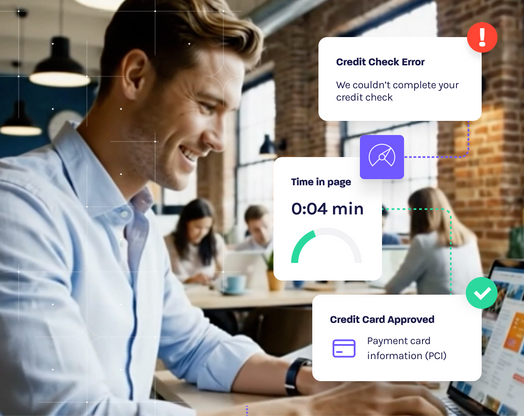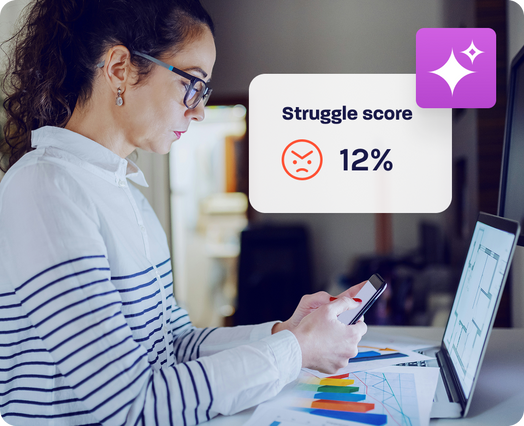
How to Check Website Accessibility
Making your website accessible starts with a clear understanding of what accessibility really means. In practical terms, website accessibility ensures that everyone (including people who use assistive technologies like screen readers) can perceive, navigate and interact with your digital content. If your site includes accessibility barriers, those users encounter friction instead of functionality.
The consequences aren’t limited to user experience. Inaccessible sites expose organizations to legal risk under ADA website compliance, invite costly remediation efforts and weaken trust with users who expect equal access. Financial institutions, in particular, face growing pressure to deliver secure, compliant and user-friendly online journeys.
In this guide, we’ll explain how to check website accessibility effectively. You’ll learn the difference between automated and manual methods, explore which accessibility checkers work best for your team and see why Glassbox offers deeper visibility than traditional tools. We’ll also walk through how to detect accessibility issues, monitor for compliance and build more inclusive experiences.
What Is Website Accessibility?
Website accessibility is the practice of building digital experiences that work for everyone, regardless of disability, device or method of access. A truly accessible website allows people to complete the same tasks without barriers—whether they're using a mouse, a keyboard or a screen reader.
Some examples of key accessibility features include:
Descriptive alt text that conveys visual content audibly for screen reader users
Color contrast that meets visibility standards for low-vision users
Proper heading structure and ARIA landmarks to support screen reader navigation
Keyboard operability for all interactive elements like forms, menus and buttons
These aren’t just best practices. In the U.S., the Americans with Disabilities Act (ADA) and Section 508 require accessible digital properties. Across the EU, the European Accessibility Act adds similar requirements. Most of these regulations align with the Web Content Accessibility Guidelines (WCAG), which define how accessibility is measured and tested.
Whether you manage a public-facing site or internal user portal, accessibility compliance is now a baseline requirement, not a bonus feature. An accessible website isn’t just more usable, it’s legally safer, easier to navigate and more likely to convert.
What Is WCAG and Why It Matters for Website Accessibility
WCAG is the global standard for digital accessibility. Published by the World Wide Web Consortium (W3C), WCAG turns diverse user needs into a consistent framework for evaluating web content and interactions.
At the heart of WCAG are four “POUR” principles:
Perceivable: Content must be presented in ways users can identify—visually, audibly or tactually
Operable: Navigation must work via keyboard, mouse or alternative input devices
Understandable: Layouts and actions must be logical and consistent
Robust: Sites must be compatible with current and future assistive technologies
WCAG defines three conformance levels:
Level A: Basic support
Level AA: Industry standard for usability and compliance
Level AAA: Highest level, typically reserved for highly specialized use cases
Today, most businesses aim for WCAG 2.1 or 2.2 Level AA, especially in regulated industries like finance and healthcare. That’s because WCAG violations are often cited directly in ADA lawsuits, and meeting Level AA standards demonstrates due diligence. Beyond risk mitigation, WCAG compliance also supports broader CX goals, such as removing roadblocks, boosting satisfaction and increasing engagement across all user groups.
As the guidelines evolve, they reflect changing technologies and user expectations. Keeping your accessibility standards current helps future-proof your site and sends a clear message that inclusion isn’t optional.
How To Check Website Accessibility
Checking website accessibility helps ensure your digital experience works for everyone—including users with assistive technologies like screen readers or keyboard navigation. But true accessibility requires more than a quick scan. It takes the right mix of tools, methods and human insight to catch and fix issues before they affect real users.
Whether you’re a developer, site owner or compliance lead, here’s how to check your site using today’s most effective testing platforms, browser tools and accessibility checkers:
1. Automated Accessibility Testing Tools
Automated testing is the fastest way to identify widespread accessibility issues across your web pages. These tools scan site code for known violations of the WCAG, including missing alt text, poor color contrast and misused ARIA roles.
These options often provide quick results and are useful for:
Checking multiple pages for accessibility violations
Getting baseline accessibility scores during agile development
Validating updates with CI/CD pipeline integration
Automated testing is efficient, but limited. These tools can’t tell you if dynamic components or real-world user flows are truly usable with assistive tech. Think of them as a helpful first pass, not a complete solution.
2. Manual Accessibility Testing
To get a complete picture, you’ll need manual accessibility testing. This process involves human testers (often including accessibility experts or users with disabilities) navigating your site using keyboard navigation, voice commands or screen readers.
Manual testing identifies accessibility problems that automated scans miss, such as:
Inaccessible form fields or error messages not announced by screen readers
Confusing focus order or modal traps
UX components that are technically compliant but practically unusable
Manual reviews are essential for high-priority flows like signups, checkouts and secure logins. However, they can be time-consuming, so most teams use them selectively alongside automation.
3. Built-in-Browser Tools
Your browser can be a powerful web accessibility checker—no external software needed. Oftentimes, built-in browser tools let you:
Run accessibility audits in real time as you develop
Highlight missing semantic HTML elements and ARIA landmarks
Visualize keyboard focus paths and element tab order
Paired with a color contrast checker, these tools are useful during early development and sprint cycles. But ongoing monitoring with browser tools is manual and time-consuming, making them less practical for enterprises that need continuous oversight.
4. Accessibility Widgets and Overlays
Many sites install accessibility widgets or overlays that promise to solve everything with one click. But these scripts often cause more harm than good by:
Masking real accessibility issues without addressing root causes
Breaking screen reader functionality or trapping keyboard users
Failing to meet ADA website compliance or WCAG Level AA standards
Because widgets can’t provide full coverage, teams still need to check website accessibility manually—an approach that becomes costly and time-intensive over time. Continuous compliance requires more than a patch or plugin.
5. Enterprise-Level Accessibility Platforms
If you manage a large, dynamic site or operate in a regulated industry, you’ll need more than browser tools or widgets. Enterprise platforms provide the scale, automation and depth needed to manage accessibility across digital properties.
Glassbox is the only platform that combines accessibility testing with digital experience analytics. With Glassbox, you can:
See how actual users (including those with disabilities) experience your site with real-time session replay
Monitor accessibility continuously across web and mobile environments
Get HTML-level remediation guidance tied directly to specific issues
Access aggregate accessibility reports that make it easy to stay compliant
Receive real-time alerts when new barriers appear
Instead of relying on manual scans or piecemeal tools, Glassbox helps you check website accessibility at scale, tying compliance directly to real-world user behavior.
How Often Should You Check Website Accessibility?
Just like performance or security testing, website accessibility checks need to evolve with every content update, code push or design refresh. Even a small UI tweak like updating a calculator widget or swapping out a hero image can unintentionally introduce accessibility barriers.
So how often should you test? The rule of thumb: Check website accessibility every time your digital experience changes.
Here’s a practical cadence to follow:
With every release: Review the accessibility report alongside QA to confirm new features don’t create barriers
Monthly scans: Set a reminder to check your site-level accessibility score and track progress over time
After UX/UI redesigns: Validate new typography, color palettes, navigation and form behavior
Post-major deployments: Confirm screen reader paths and keyboard focus are intact
Many accessibility testing tools require separate audits or developer intervention to trigger scans. But with Glassbox, real-time monitoring is built in. That means your site is continuously scanned in the background—across desktop and mobile—without interrupting your development flow.
The result? You’re not waiting weeks for a report. You’re resolving accessibility issues before customers even notice them.
Real-Time Accessibility Monitoring With Glassbox
Traditional audits stop at surface-level scans. Glassbox takes website accessibility testing deeper, mapping real user sessions to actionable insights that reveal where, why and how your site falls short of WCAG Level AA compliance.
Here’s how it works:
Full-Coverage Monitoring
Track accessibility performance across web, mobile and dynamic environments, so you never miss an issue, no matter the device or page type.
Session-Based Scoring
Every visit is automatically scored for accessibility. You can benchmark performance, monitor trends and prove compliance over time.
HTML-Level Guidance
Each accessibility issue is tied to specific HTML code and paired with clear recommendations, giving dev teams the clarity to fix fast.
Contextual Session Replays
See what your users saw. Replay sessions with accessibility overlays that pinpoint missing alt text, focus traps, color contrast failures and more.
Role-Based Dashboards
From developers to compliance officers, stakeholders can drill down into issues, order by severity and be alerted when new issues arise.
Zero-Tag Implementation
Thanks to Glassbox’s tagless architecture, setup is simple—no additional installation is required. Monitor, analyze and act without slowing down your site.
Unlike standalone accessibility checkers or overlays, Glassbox connects every accessibility insight to real user behavior. That means you can prioritize what actually affects conversions, engagement and user experience, not just what breaks guidelines.
Make Website Accessibility a Competitive Advantage
Making your website accessible isn’t just about compliance. It’s about expanding your reach, improving usability and showing every customer they matter.
With Glassbox, you move beyond generic audits to a modern accessibility strategy powered by:
- Live session analysis
- Continuous WCAG compliance monitoring
- Real-time issue detection and scoring
- Developer-ready remediation insights
And because accessibility is just one part of delivering great digital experiences, you can layer in complementary strategies like digital experience optimization, customer behavior analysis and personalized customer journeys—all within the same platform.
Take the First Step Toward Inclusive Design
Digital accessibility can feel overwhelming, but it doesn’t have to be. Glassbox makes it easy to start, scale and sustain your accessibility efforts with tools that work behind the scenes to protect your brand and empower your team.
Ready to simplify compliance, improve conversion and build more inclusive experiences? See how effortless it can be to check website accessibility (and fix it) right at the source.







